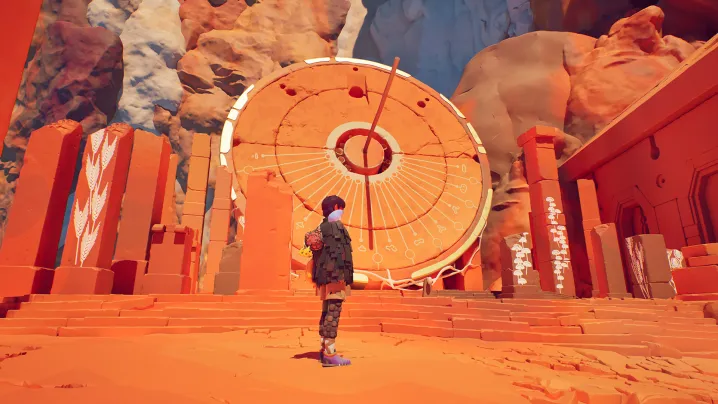“Jusant's creative take on climbing and a minimalistic approach to storytelling make it one of the boldest titles from Don't Nod so far.”
- Involved climbing gameplay
- Relaxing vibes
- Relevant message
- Buggy when moving off path
October 2023 was one of the busiest months I’ve ever had covering the video game industry in my professional career. I reviewed new Assassin’s Creed, Forza Motorsport, Hot Wheels, Ghostrunner, and League of Legends games while also keeping up to date with hidden gems and major AAA releases like Marvel’s Spider-Man 2 and Super Mario Bros. Wonder. While playing all those games back-to-back could get stressful and exhausting, Jusant provided a relaxing, meditative, and welcome break between those other titles during the extended review process.
Jusant is the latest game from Life is Strange and Tell Me Why developer Don’t Nod, but it’s quite subversive and different from the studio’s other games. Instead of being a dialogue- and choice-filled choose-your-own-adventure experience, it’s a minimalist game with no dialogue that’s all about climbing a tall, abandoned tower in a world where water is scarce.
Despite the drastic differences from Don’t Nod’s past work, Jusant is one of the studio’s best games since it left the Life is Strange series behind. Its trigger-based control scheme makes climbing and traversal fun, and the constant introduction of new ideas and twists across its five chapters overshadow any issues that emerges in a five-hour playthrough. When you have a moment to just sit back, relax, and play a game, Jusant makes for an excellent option.
A minimalistic aesthetic
Jusant isn’t a very story-forward game. All I initially see in dialogue-free scenes is that this is a world mostly devoid of water. The main character, however, has a small creature made of water called Ballast and wants to climb to the top of a giant tower jutting out from the seafloor. This intentionally minimalistic approach is reflected in the game’s visual design, which is colorful, but full of smooth low-poly-style textures that add to the feeling that this is a tower and long-gone society that nature has started to smooth over.

The bulk of the narrative and the history of this tower is up for the player to piece together through the emotional and cinematic framing of certain scenes and the collectibles that they find. Those included scattered notes and letters left behind on the tower, as well as beautiful murals and seashells that the player can listen into to hear vague whispers of what the society of this tower used to sound like. The end of each chapter rewards players by showing them how flora and fauna are returning to the section of the tower that they just climbed.
While interpretations will vary from person to person, Jusant has something to say about humanity’s relationship to the Earth, how we treat the environment, and how society needs to give back just as much its takes from nature. With UNESCO saying that a global water crisis is imminent, I have a feeling that those who piece Jusant’s story together will find that it will only get more relevant over time.
The climb
Although Jusant’s themes are pretty heavy for a game I’m describing as relaxing, that description still fits because it’s on the player to engage with the narrative elements on a deeper level. If they don’t, their focus can be on the climbing. Jusant eases players into its climbing mechanics, starting with simple third-person exploration and a jump button like what you’d see in most 3D games. That will only get someone so far on this massive tower; more involved climbing is required to get where the player and Ballast need to go.
The bulk of Jusant is spent climbing up rocks, cliff faces, and sometimes even the backs of insects and animals. Climbing controls in a very distinct way, as each trigger corresponds to the grip of a hand. That means that to climb up a wall, I had to point the control stick in the direction of a hold I wanted to grab onto and then press down on the trigger to do so.
It’s a slow experience, but that works in the adventure’s favor.
While most games leave climbing to the control stick or a specific button, using the triggers feels surprisingly natural. VR games like Synapse use this control scheme for climbing, and Jusant demonstrates how it can also work well for console games. I also had to keep track of my character’s stamina, taking brief respites to let the meter refill occasionally. It’s a slow experience, but that works in the adventure’s favor to make it relaxing.
Pressing the triggers to climb gives real-life tactile feedback, which makes it satisfying to climb upwards and helps put me in a relaxed trance while playing Jusant. It’s a good game to play while listening to a podcast or other music. However, there are specific points where listening to occasional spurts of Jusant’s audio adds to the experience. I always feel like I can take my time and climb this tower at my own pace. Fittingly, Jusant served as a respite to help me refill my own stamina between playing and reviewing many other games this month.

Don’t Nod spices up that core climbing gameplay loop with a variety of other systems and tools. Rope plays as a critical role in the game as a resource like stamina does. Pitons dot the walls and sides of this tower. As I climb, I’m always attached to one of these through my carabiner, and I can even place secondary pitons as I ascend. If I stray too far, I run out of rope, so searching and finding pitons to attach to essentially serves as the game’s checkpoint system. The rope has a variety of other uses, as it can be used to swing or wall run across big gaps.
Jusant frequently introduces new twists on those core climbing fundamentals, like sun-scorched spots where stamina drains faster or wind that massively boosts my jump distance. Even though the game is only around five hours long, about every half-hour recontextualizes the core climbing in some way. Jusant never gets too difficult — there isn’t even much of a fail state besides falling to where your last piton is — but finding these systems spices up the climb.

Unfortunately, there were occasional moments where a missed jump, poorly placed piton, or overshot wall run got me to an area where the game didn’t expect me to be. These moments would sometimes lock part of the controls, make the camera jitter, or leave me with no natural way to escape. While there are typically multiple paths the player can take up through the level, these moments demonstrate how Don’t Nod still wants players to follow some very specific routes. That works against the free-climbing feel of the gameplay, but thankfully, it only reared its head due to a couple of climbing mistakes during my adventure.
While playing Jusant, I enjoyed the meditative aspects and simplistic satisfaction of climbing up a giant, colorful tower with minimal narrative interruptions. Jusant is a game unlike anything its developer has done before, and it makes me hope that Don’t Nod continues to experiment with new styles of narrative and gameplay in the future. While, for other players, this game won’t be the respite between October’s big game releases that it was for me, it’s still a short experience to decompress with and be pleasantly surprised by over and over again.
Jusant was reviewed on Xbox Series X.





